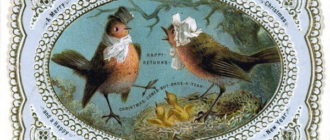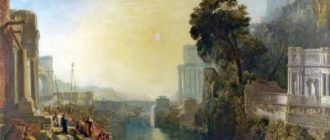
Cross in the Mountains (Techensky Altar) by Caspar David Friedrich is an attempt to convey the presence of God through the natural elements
Cross in the Mountains (Techensky Altar) is a painting by Caspar David Friedrich, created with a departure from traditional iconography towards the landscape. Unrealistic lighting gives the romantic image a mystical meaning. Two light sources are located behind the impenetrable foreground. The viewer does not see them, but brown stones, dark green silhouettes of trees, purple shadows, a gray sky in cirrus clouds – everything is flooded with a golden glow. What are these fading lamps? The upper part of the image gives the answer to the question. The first is the setting sun. The second, from which five barely noticeable rays depart, is probably the Creator.
An ivy-covered cross is facing Him, turned three-quarters from the viewer. The Crucifix raised above the earth, according to the author, is an allegory, the meaning of which is in the “dying of the wisdom of the old world.” God is gone, the earth without Him descends into darkness. Salvation for all remains faith, which must be strong as a rock and unchanging. The picture seems to be a reflection on the place of the image of Christ and his sacrifice in the life of every person.

Name of the painting: “Cross in the mountains” (Techensky altar).
Author: Caspar David Friedrich (1774-1840).
Year of writing: 1808.
Size: 115 x 110.5 cm.
Style: Romanticism.
Genre: Landscape. Religious. Historical.
Technique: Oil painting.
Material: Canvas.
Location: New Masters Gallery, Dresden, Germany.
Caspar David Friedrich – German artist of the last third of the 18th – early 19th centuries
He supported the romantic direction of painting, tried to reflect human helplessness against the backdrop of the elemental forces of nature.
In order to achieve the correct angle, Friedrich arranged in his workshop a copy of the throne on which the painting would stand. This is evidenced by one of the sketches of the author.
According to the surviving information, initially the “Cross in the Mountains” was not intended for the church. But when Countess Theresia von Thun-Hohenstein saw the pencil and sepia drawing, she fell in love with the image and commissioned the original for the Catholic chapel of her castle in Techen, Bohemia. Since that time, the name “Techensky altar” has been strengthened behind the work.

To create a landscape, the master used sketches from nature.
Despite the fact that the trees in the final version are placed as if they are very far away from the viewer. To give them a recognizable look, Friedrich used sketches made from spruce.
The frame with Christian symbols was made by Christian Kuhn. The sketch was developed by the author himself. The arched top is crowned with a star, below it are five cherubs. At the base is a triangle with the All-Seeing Eye, surrounded by ears of wheat and grapes – symbols of the Eucharist.

Disputes around the altar panel did not stop even after the death of the master. The work has been criticized for its unconventional approach. In the 20th century, the artist was very popular in Nazi Germany. The Fuhrer considered the painter’s work a model of Aryan art. The painting “Cross in the Mountains” (“Techensky Altar”) by Caspar David Friedrich was first presented to the public in 1808. Currently, the work is carefully stored in the Galerie Neue Meister in the German city of Dresden.







